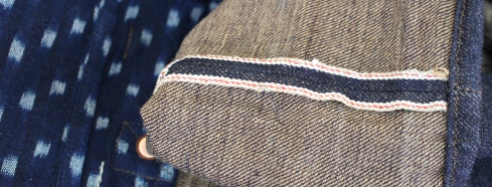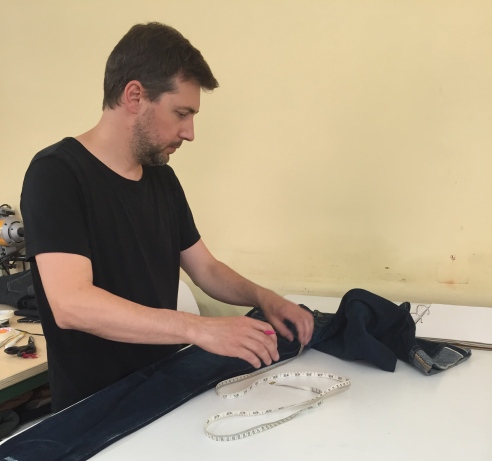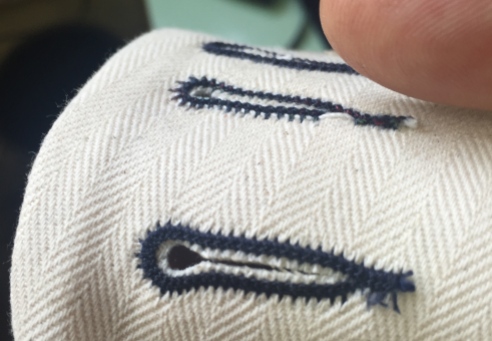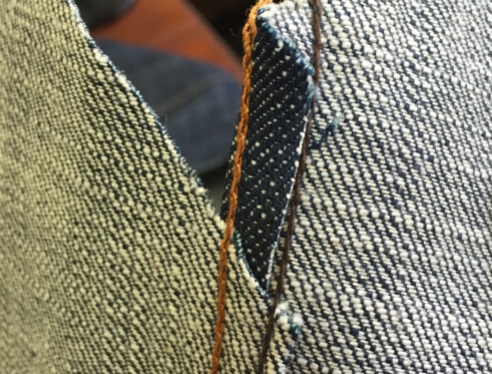This summer I decided to go on a pilgrimage. Not in the traditional sense of seeking out a holy place of note and walking there, mind you. More in the way of a growing awareness of going to be quite near a destination of note for enough time to allow me to saunter by to say “hola!” kind of thing. You know the idea, getting as much value out of your travels as possible.

Yes, this is for real, it’s the Sagrada Famila, a cathedral by Spanish architecht Gaudi. Construction was started in 1883 and is still ongoing. In fact, when I visited there was plenty of on site activity.
My destination was Barcelona, home of much fine stuff, such as buildings by Gaudi. I suspected these were the origin of the expression “gaudy” (though the briefest of Googles proved me wrong, and also that I wasn’t original in thinking it might be so), in addition to being quite the finest examples of marvellously whacky architecture around. The city is also home to good folks like Companion Denim, maker of arguably the finest jeans you can buy.
Getting to the Companion workshop involved taking a very pleasant train ride out of the city and then an introduction to life in a Barcelona suburb as I walked in the scorching sun along narrow streets, lined with low buildings. Finally though I was met by Iu, mr Companion himself, outside his secret HQ and workshop in an anonymous corner building.
You may wonder why it is that you haven’t heard talk of Companion before and mainly that is down to it being literally a one-man operation. The workshop is decently large and stocked with a great collection of mainly rare and vintage machines for the various operations of sewing jeans, but there isn’t a huge team of seamstresses at work, merely Iu, the lone seams-man.
In a world where the number of hands that have been involved in producing jeans, one pair is as low as it gets. I’ve been enjoying an pair of Livids (2 pairs) and Tenders (probably 3 pairs) for a while now, so until someone manages to sow single-handed, one pair of like the grail of low finger count production!

This is indeed something special: Kakishibu denim with natural indigo warp and persimon weft, with ikat dyed fabric inside.
That means that output is limited. We talked about this for a while, as I was curious about how long it actually takes to put together a pair, compared to how a huge factory would produce thousands of pairs a day. I was intrigued to find that Iu only manages a little more than a single pair a day.
A typical large factory will have computer controlled laser cutters, cutting up pieces for many trousers at once. The pieces will then move from station to station, having one operation performed optimally at each place. A back pocket may sewn in place in seconds. And of course, this efficiency means cost is cut.
At Companion though, there isn’t a massive production of standard sizes and models. Most of it comes down to the custom or semi-custom service Iu provides. Some of the production is to standardised designs and sizes, while much of it will be variations in size, model and special details. Or even entirely custom made. This means that there is little opportunity for streamlining production, but at the same time you are ensured that Iu is paying total attention to the pair of jeans he is making.

To get a good fit for a pair of custom jeans it can be a good idea to let Iu take measurements from a pair that are known to have a good fit. Here a pair of Norwegian Livid Jeans are being measured up.
And this attention is what Companion are about. Iu has around 60 types of denim in his library. From regular issue selvedge denim up to rare Japanese denim so esoteric that the denim itself costs as much as a most guys would consider paying for half a dozen pairs of more common jeans. Just looking at the rolls of denim is a strange experience, as for most guys denim is pretty much denim, yet here are 60 variations, all subtly different in colour, weight and texture. And available for the connoisseur to choose from.
Being something of a nerd I was drawn to to the collection of vintage machines in use. Two of these I will pay special attention to, as I know I’m not the only guy to be fascinated by this. The first is the machine for making button holes. Not only does it sew the stitches round the buttonhole in around 6 seconds, it also cuts the hole itself. With total precision. Not bad for a machine that has been in use since a good while before the first electronic computer was invented.

Vintage Reece buttonhole machine. Still in daily use, though can be heavy on servicing requirements!
And the result of those 6 seconds is a perfect buttonhole, with strengthening and hole, ready to use. Quite remarkable. I’ll add a video further down so you can fully enjoy this entirely mechanical marvel, ok?
The second machine I wanted to take a look at was the one for felling seams. Felling seams is something of an obsession with me, as I greatly prefer the look and feel of a seam that has been felled to the typical hasty and basic overlocked seam. Naturally, most Companion jeans feature felled seams. The photo below shows how the fabric is folded and sewn to give a nicely finished seam. See video below for full steaming action.
While Iu had his back turned I managed to sneak a couple of snaps of some upcoming new products being developed in his Secret Denim Lab. I don’t know if you’ll make sense of this partial snaps, but I did my best to provide you with quality corporate espionage.
All in all I spent a very pleasant couple of hours (or a third of a pair of jeans i Iu-time) talking denim with my graceful and patient host. Will there be a pair of custom Companion Denim jeans in my future? My lips are sealed for now, though if you were up close right now you couldn’t fail to notice a single eyelid engaging in a definite and repeated up-down motion.























Først tenkte jeg at denne artikkelen ble vel nerdete for meg, men når jeg bare tok meg tid til å lese den, så må jeg si at den var jammen meg interessant (er jeg i ferd med å ble en nerd?). At det finnes egne hullemaskiner var jeg ikke klar over, samt at dette var vintage-greier. Kult!
Keep ut the good work!